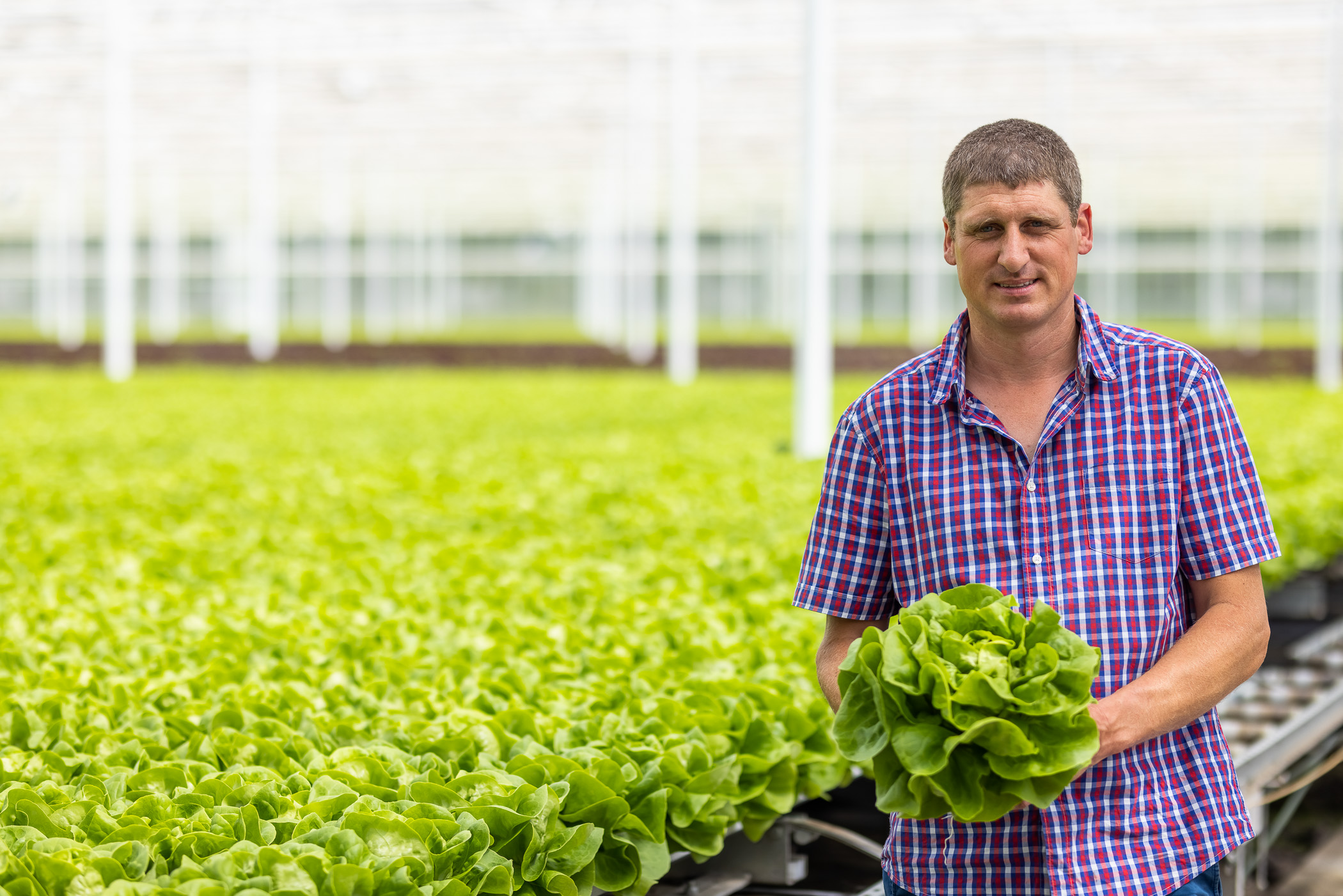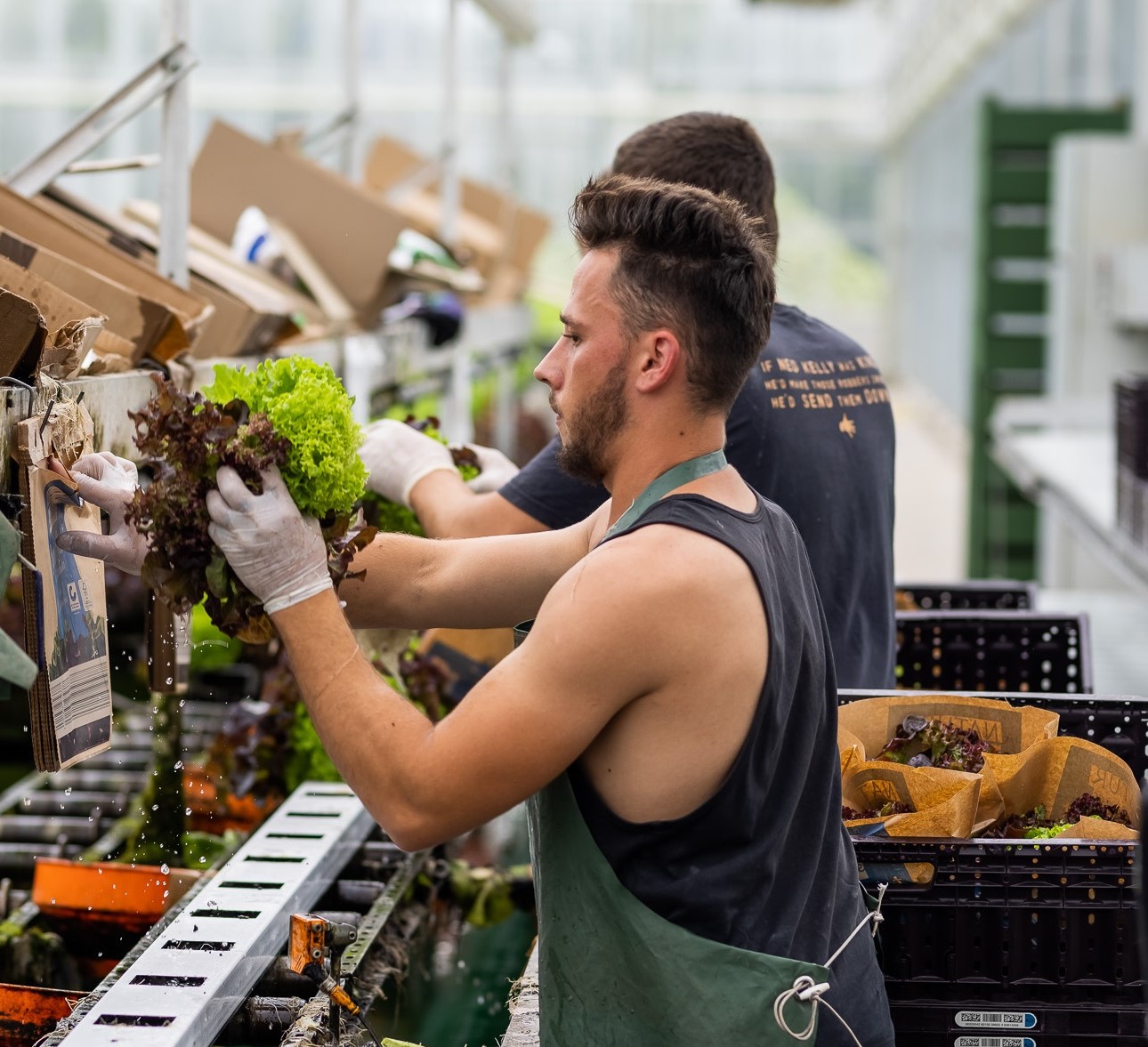Sustainability in lettuce production - a practical example
Bert Depoortere and Evelien Vandewaetere from Ardooie in West Flanders have been passionate about lettuce production since 2008. In 2016, the couple invested in a new 12,000 m² greenhouse. They currently cultivate a greenhouse area of 24,000 m².

Bert Depoortere has dedicated himself passionately to lettuce production. Photo: ©VLAM
The company's portfolio includes multicolor lettuce - consisting of three lettuce varieties that grow together in a small root ball - as well as conventional lettuce.
"Both types of lettuce are grown using the ergonomically advantageous hydroponic method. The benefit of this is that all activities can be carried out comfortably while standing. Another significant advantage of hydroponic cultivation, especially in times of climate change, is the resource-efficient use of water, nutrients, and energy. Additionally, the space-saving gutter system and the shortened growing period compared to soil cultivation allow for more efficient use of available greenhouse space. Last but not least, retailers can rely on a consistent, high-quality product throughout the year," says Depoortere.
The greenhouse is made of hardened, highly durable glass that is more light-permeable and features coatings on both the top and bottom. Thanks to the greenhouse's height of 5.60 meters, the LED lights can be positioned to ensure even light distribution. This allows the lettuce to grow optimally, especially during the sunless winter months. Unlike open field lettuce, greenhouse-grown lettuce is protected from extreme weather conditions like heavy rain or hail, thus preventing crop failures.

The greenhouse is made of hardened, highly durable glass. Photo: ©VLAM
For irrigation, primarily rainwater is used, which is stored cool and dark in an underground cistern.
From an energy perspective, the operation is also well-equipped: a gas-powered combined heat and power (CHP) system generates both electricity and heat.
"The greenhouse in Ardooie is equipped with a modern gutter system that can be hydraulically controlled. The young plants are initially placed in so-called tray plates on the water, where they stay for a week. After that, they are transplanted into the growing gutters. The nutrient-enriched water flows through the gutter floor. Not a single drop of water is wasted. Excess nutrient water is reintroduced into the water cycle after being filtered and disinfected. This helps prevent diseases and algae. Thanks to controlled cultivation, the use of plant protection products is minimized to the absolute minimum," explains Depoortere.

The young plants are initially placed in tray plates on the water. Photo: ©VLAM
The enthusiastic lettuce producer continues: "Depending on the progression of the growth process, the distances between the gutters increase. Every day, the lettuce is in a different location – sometimes in the shade, sometimes in full light. This helps the plants develop more uniformly. In the summer, the journey of the multicolor and head lettuce through the greenhouse takes 2.5 and 4 weeks, respectively. During the sunless winter months, the LED lighting ensures optimal growing conditions. However, the lettuce requires more time then: While the multicolor lettuce stays in the greenhouse for four weeks, head lettuce needs two additional weeks. For comparison, multicolor lettuce planted in soil has a four-month growing phase. At the end of their journey through the greenhouse, the lettuce plants are carefully removed from the gutter; then the multicolor lettuce with root ball is carefully packed into special bags. After the harvest, the gutters are automatically moved forward and are ready for the next planting."

The multicolor lettuce with root ball is carefully packed in special bags. Photo: ©VLAM
Every morning, Depoortere delivers the lettuce harvest to the REO Auction in Roeselare. The goods auctioned off in the morning are on their way to customers by noon and impress with their crisp freshness on the vegetable shelves of grocery stores the next morning. Consumers greatly appreciate the significantly longer shelf life of the multicolor lettuce with root ball – especially because much less waste ends up in the trash, helping to combat food waste.